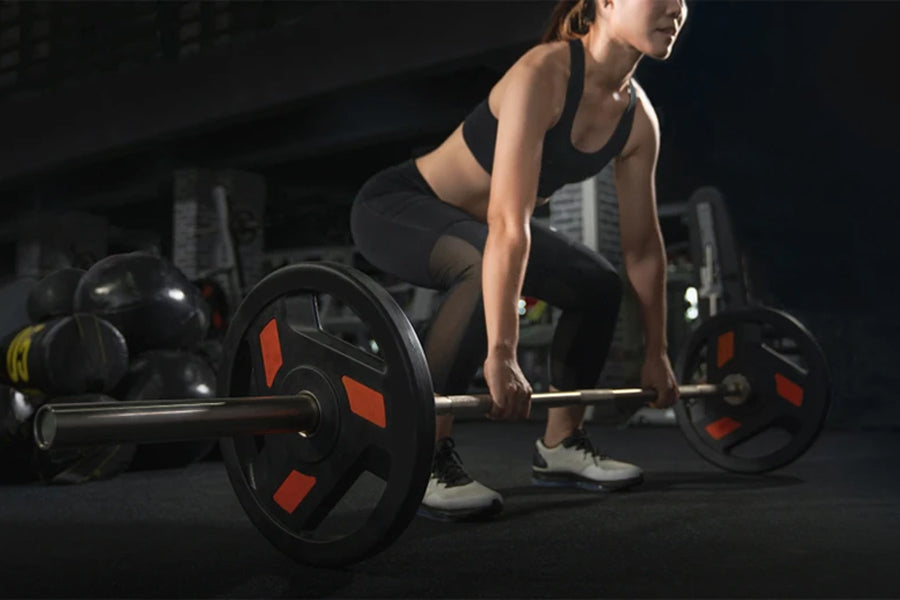If you are a weightlifter or trying your hand at it for the first time, you might be a little confused about which bar to buy. You might as well think that they are all the same, but that's not the case. Some obvious and subtle differences require wiser and more thoughtful consideration.
Do not just pick any bar; you need to figure out which style of lifting you will do with your bar. This consideration makes the decision for you because all bars look identical, but they come with specific features for particular lifting styles.
The open bars and power bars are two basic and most widely used lifting bars, and they come with markedly different features. The rigid, rugged, and deeply knurled power bars are not suitable for those who are going for Olympic lifting/weightlifting. In the same way, the slight flexing of the open bars and lack of central knurling is not for powerlifters.
Know your bars and tasks (whether you are doing simple (weightlifting or powerlifting) before and save your money from going down the drain with the wrong type. This article will make the differences between the open and power bars clear to help you choose better according to your needs.
What Is a Powerlifting Barbell?

It's a weightlifting bar that looks just like any other bar. It's made from high-grade steel and has remarkable weight lifting capacity. You will mostly see central knurling in a powerlifting bar that helps stabilize weight on the back and shoulders during squats.
A power bar is a very rigid steel bar, and there is no feature to allow flexibility or thrust as in the Olympic/ open bars.
The power bars also come with deep, aggressive knurling, which ensures a safer and more solid grip during the potentially dangerous powerlifting moves. Stability and solid grip are essential during powerlifting, and these bars are made to match these very concerns.
Powerlifting bars are specifically designed to aid powerlifting moves like deadlifts, bench press, and deadly back squats. The slow and steady massive, intense lift that is part and parcel of powerlifting will only be possible with a solidly structured bar.
Powerlifting moves are very controlled and measured movements, unlike the Olympic lift, which is more about a whip and swish with the weight. So the power bars are quite unlike open bars too.
Powerlifting Barbell Features
- Powerlifting bars are made from solid steel to help facilitate slow, controlled movements with minimal whip action.
- Center knurling to maintain friction on your back when performing squats
- Deep knurling to provide a no-slip grip during the hardcore powerlifting moves
- Thicker shaft to be more comfortable for bench presses and squats
- Steel or brass bushings for a rigid frame and to avoid whipping
- High tensile strength to withstand being slammed repeatedly on a rack. It adds to the durability of the bar
Pros of Powerlifting Barbells
- The rugged and deep knurling of these bars helps the lifters hold the bar tightly. There is no danger of the bar slipping in your hands. A slip of grip can be dangerous in extreme situations like powerlifting.
- The center knurling of these bars aids back squats. When you let the weight sit on the back during back squats, the central knurling helps stabilize the weight there. If it slips in that position, it can be destructive for you. There are chances of pretty bad, irreversible injuries as well as posture misalignment. Central knurling on the power bars ensures your safety by making the weight stick to the back during the squat.
- The extreme strength and weight-bearing capacity help afford safety to the lifters. Athletes have to lift a crazy amount of weight during powerlifting. Solid high-grade steel structures of the bars can bear anything and everything.
- The fat grips help engage larger muscle groups in the body instead of making the wrists do all the work. This means you build more muscles and increase strength (the core purpose of powerlifting) as large muscle groups are engaged in the weightlifting activity. Fat grips are more suitable for bench press and back squats as well. They distribute weight evenly on the bar and help ease the extremities of powerlifting.
- The power bars are extra stiff and rigid, and that serves the purpose as long you are using them for powerlifting moves only. If, however, you use them for Olympic competitions, you will have to face some annoying disadvantages.
Cons of Powerlifting Barbells
- The central knurling of the powerlifting bars is a hazard for other types of weight lifting where it can hurt the neck in front during cleans (a move in Olympic lifting)
- The fat grips of power bars are great for powerlifting, but they are not suitable for other types of weightlifting.
- The rigidity of these bars is not a very attractive feature for Olympic lifters or any new lifters.
- Power bars lack the thrust that makes overhead lifting easier.
- They are not multipurpose. They are specifically just powerlifting bars.
What Is an Open Barbell?

A open barbell is like a power bar as far as the outlook is concerned, but there are some important differences that you will learn when you dig a little deeper. The open bars are made from solid steel and have a great weight-bearing capacity. They also offer massive tensile strength that makes the bars extremely durable and long-lasting.
The regional bars have roller bearings in the sleeves, giving a bit of thrust for overhead lifting. They offer a great whip: you may struggle with powerlifting if you are using this bar. Lack of central knurling helps with Olympic lifting.
The power barbells are perfect for Olympic weightlifting, where you need a bit of whip to finish the move perfectly. However, they are quite a jack-of-all-trades or say multi-purpose in nature. You can perform different types of weightlifting with your regional bars. They will stand the pressure of powerlifting even.
Open Barbell Features
- More flexible structure to facilitate the whip which is necessary for Olympic lifting
- Perfect placement of knurling for easy and steady grip
- Soft or medium knurling on these training bars so the bar can slide during your transition from the pull to the catch.
- Thinner shaft for a good pulling grip; thin grips make pulling a lot easier
- Roller bearings so you can transition your wrists to catch the bar in rack position on your shoulders ( they are an important feature of a regional bar)
- No central knurling make them ideal for various types of weight lifting
Pros of Open Barbells
- They are made from high-grade steel and offer incredible strength and durability. The weight bearing capacity goes up to 1,000 lbs. which is absolutely incredible.
- They are not extra rigid structurally and that accommodates many styles of lifting
- They come with a great tensile force that helps them stand the repeated slamming, unavoidable during these lifts. Tensile force marks the breaking point of a bar and it is measured in PSI (pounds per square inch). Higher PSI (ideally anything around and above 150,000 is great) of the bar makes them extremely durable. These bars are not really cheap, so it makes sense that you buy something that is built to last long.
- Open bars have central knurling to make overhead lifts safe
- The thinner or standard grips of open barbells engage wrists and hand muscles which are perfect for pulling and stabilizing the weight on the bar
- The 1.2mm diamond knurl on the bar allows the grip adjustment needed during transitions (from pull position to catch for cleans) in Olympic lifting.
- The open bars come with roller bearings in the sleeves, giving the right amount of whip or thrust for weight lifting. They also help you transition the wrists swiftly as you rack the weight on your shoulders.
- The black phosphate coating on the shaft saves it from wear and tear
- These bars come with color-coded, silicon rings that signify a particular weight like blue is 20 kg, yellow is 15 kg, etc.
- The solid steel structure, black phosphate coated central shaft and chrome sleeves give it a very serious and hardy look.
- The open bars are perfect for your lifting endeavors and suit many lifting types.
Cons of Open Barbells
- The non-aggressive, light knurling will not be ideal for powerlifting.
- The open bars have bearings in the sleeves which give a perfect whip for lifting, but this same feature might make the weight wobble in powerlifting moves like deadlifts, bench press, etc.
Conclusion
Weightlifting is a hard task to start with, and you would not want to make it harder with the wrong type of weight lifting bar. It's important to choose a suitable bar for your lifting endeavors. All bars may look the same on the outside, but there are different bars for different lifting styles.
The power bars are not for Olympic lifting: they support only powerlifting moves. However, some bars are truly multi-purpose like the open bars. They facilitate multiple lifting styles and you can move from one style to another with the one bar without worrying. You just need to be sure of your weightlifting type/types and that will make the decision for you.
Article Sources
- Krings, Ben M., et al. ‘Impact of Fat Grip Attachments on Muscular Strength and Neuromuscular Activation During Resistance Exercise’. Journal of Strength and Conditioning Research, vol. 35, no. Suppl 1, Feb. 2021, pp. S152–57. PubMed, https://doi.org/10.1519/JSC.0000000000002954.











